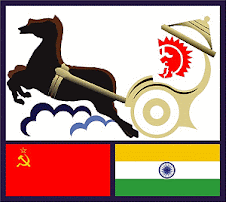The Name SOYUZ - Space craft :
Soyuz (Russian: Союз, pronounced So’jus English: Union) is a series of spacecraft designed for the Soviet space program by the Korolyov Design Bureau. The Soyuz succeeded the Voskhod spacecraft and was originally built as part of the Soviet Manned Lunar program. The first unmanned Soyuz mission was launched November 28, 1966; the first Soyuz mission with a crew (Soyuz 1) was launched April 23, 1967, but the cosmonaut on board, Vladimir Komarov, died during the flight's crash-landing. The first Soyuz flight which the crew survived (Soyuz 3) was launched October 26, 1968.
Currently, the Soyuz spacecraft family is still in service and has launched more human spaceflight missions than any other platform.[1] The Soyuz spacecraft is launched by the Soyuz launch vehicle, initially as part of the Soyuz program, and also as part of the unmanned Zond program. Soyuz spacecraft were used to carry cosmonauts to and from Salyut and later Mir Soviet space stations, and are now used for transport to and from the International Space Station. The International Space Station maintains a docked Russian Soyuz spacecraft at all times to be used as an escape craft in the event of an emergency.
Launch Vehicle :
Russian launch vehicles are named after the payload that they carry or the spacecraft they launch. In this case, it is called Soyuz after the eponymous capsule. The first manned capsule of this series was put into Earth orbit on 23 April 1967. With a curriculum vitae that includes over 1700 manned and unmanned launches, the Soyuz rocket is the most frequently used launch vehicle in the world.
Stages
The rocket consists of three stages that provide thrust at various points in the flight until the Soyuz capsule finally settles into orbit around the Earth. The first stage consists of four boosters, each about twenty metres in length. Together, they provide the main thrust in the first two minutes of the flight and are subsequently jettisoned. The second stage, or central core, takes care of the next 168 seconds.
Soyuz launcher
The three-stage Soyuz launcher
Fuel : In less than five minutes, the first two stages burn 225 000 kilograms of kerosene and liquid oxygen. When these have burned out, the third and last stage continues the upward trajectory.
Right at the top of the structure are the manned Soyuz capsule and the emergency rescue system. When the last 22 tonnes of fuel have also been converted into forward thrust, the crew are eight minutes and forty seconds into their journey and are making a low-level orbit around the Earth. The Soyuz spacecraft separates and will continue to climb under its own power to an altitude of about four hundred kilometres, where it will dock with the International Space Station.
Subscribe to:
Post Comments (Atom)

No comments:
Post a Comment